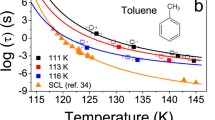Abstract
We theoretically analyze the possibility of using certain relaxation functions (relaxation kernels) for dissipative processes discovered in the internal friction spectra of two-phase unordered glassy systems at temperatures higher than the vitrification temperature. It has been found that the most acceptable functions for describing the continuous spectra of relaxation times are the Maxwell and Kohlrausch functions. We consider one of the possible methods for determining the parameters of the Kohlrausch function from the internal friction spectra of the relaxation process in the vitrification region of liquating glasses.
Similar content being viewed by others
References
V. S. Postnikov, Internal Friction in Metals (Metallurgiya, Moscow, 1969) [in Russian].
A. A. Gorshkov, A. D. Gruskov, and V. A. Lomovskoi, “Relaxation Spectrometry as a Method for the Investigation of Physical-Mechanical Material Characteristics,” in Fifth Intern. Symposium “Dynamics and Technology Issues in Mechanics of Structures and Continua” (MAI, Moscow, 1999), pp. 90–103 [in Russian].
A. A. Gorshkov, A.D.Gruskov,V. A. Lomovskii, and Z. I. Fomkina, “Study of Local Inelasticity of Composites by Dynamic Methods,” in Materials of VIth International Symposium “Dynamical and Technological Problems of Structure and Continuum Mechanics (Grafros, Moscow, 2000), pp. 89–97 [in Russian].
V. A. Lomovskii, “Internal Friction in Studies of the ‘Chemical Structure-Physical Properties’ Interconnection of Nanosystems,” in Modern Problems of Physical Chemistry of Nanomaterials (Granitsa, Moscow, 2008), pp. 287–301 [in Russian].
Yu. S. Balashov, A. B. Noskov, and N. V. Ivanov, “Processes ofMechanical Vitrification in Liquating Glasses,” in Mechanisms of Relaxation Phenomena in Solids (Izd-vo Kaunas Politekhn. Inst., Kaunas, 1974), pp. 344–347 [in Russian].
V. A. Lomovskii, “Spectra of Internal Friction and Dissipative Mobility of Elements of Aggregate and Modifying Subsystems,” Materialoved., No. 2, 3–10 (2007).
V. A. Lomovskii, “Spectra of Internal Friction and Dissipative Mobility of Elements of Aggregate and Modifying Subsystems,” Materialoved., No. 3, 3–12 (2007).
V. A. Lomovskii, “Spectra of Internal Friction and Dissipative Mobility of Elements of Aggregate and Modifying Subsystems,” Materialoved., No. 4, 3–11 (2007).
A. A. Gorshkov and V. A. Lomovskii, “Choice of Relaxation Kernels in Description of Local Processes of Inelasticity in Glasses,” in Materials of XVIth International Symposium “Dynamical and Technological Problems of Structure and Continuum Mechanics Dedicated to A. G. Gorshkov (GUPIPK “Chuvashiya,” Cheboksary, 2010), pp. 144–153 [in Russian].
Author information
Authors and Affiliations
Corresponding author
Additional information
Original Russian Text © A.A. Valishin, A.A. Gorshkov, V.A. Lomovskoy, 2011, published in Izvestiya Akademii Nauk. Mekhanika Tverdogo Tela, 2011, No. 2, pp. 169–182.
About this article
Cite this article
Valishin, A.A., Gorshkov, A.A. & Lomovskoy, V.A. Relaxation processes and their spectra in liquating glasses. Mech. Solids 46, 299–310 (2011). https://doi.org/10.3103/S0025654411020191
Received:
Published:
Issue Date:
DOI: https://doi.org/10.3103/S0025654411020191



